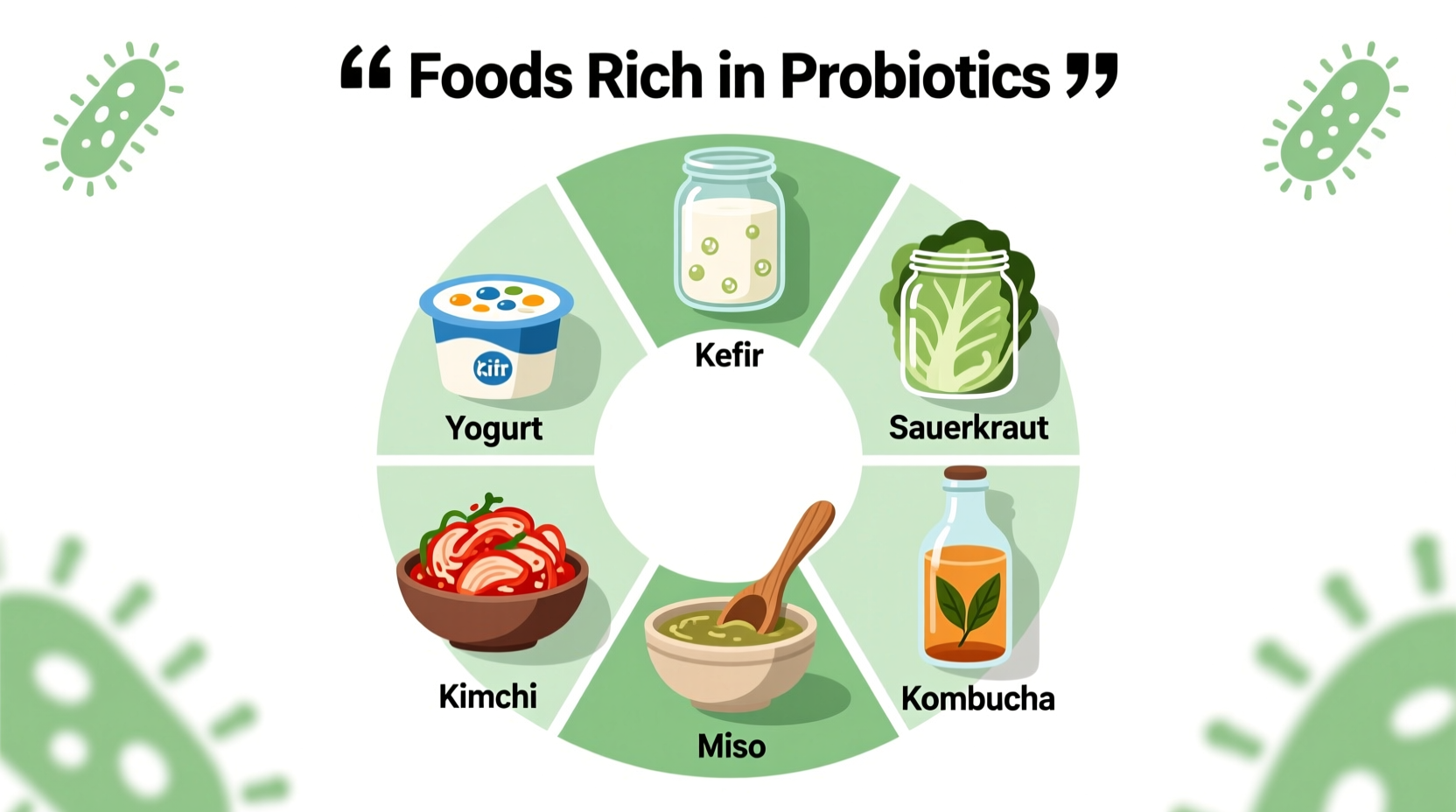Your Complete Guide to Natural Probiotic Foods
Understanding which foods naturally contain probiotics is essential for building a gut-healthy diet. Unlike supplements, probiotic-rich foods offer additional nutrients while delivering live microorganisms that survive digestion to reach your intestines. This guide provides science-backed information about the most effective probiotic food sources and how to incorporate them into your daily meals.
What Exactly Are Probiotics?
Probiotics are live microorganisms that, when consumed in adequate amounts, confer health benefits to the host. According to the World Health Organization, these "good bacteria" must survive stomach acid and bile to reach the intestines alive where they:
- Help maintain healthy gut flora balance
- Support digestion of complex carbohydrates
- Strengthen the intestinal barrier
- Modulate immune system function
- Produce certain vitamins like B12 and K
Not all fermented foods contain probiotics—some undergo processing like pasteurization or baking that kills the live cultures. True probiotic foods must contain live, active cultures verified through laboratory testing.
Top 8 Probiotic Food Sources Ranked by Effectiveness
| Food | Key Strains | CFUs per Serving | Best Quality Indicators |
|---|---|---|---|
| Unpasteurized Sauerkraut | L. plantarum, L. brevis | 1-10 billion | Refrigerated, no vinegar listed |
| Kefir | L. kefiri, L. acidophilus | 5-10 billion | Cultured at home or labeled "live cultures" |
| Yogurt with Live Cultures | S. thermophilus, L. bulgaricus | 1-5 billion | "Contains live active cultures" seal |
| Kombucha | Various yeasts & bacteria | 0.5-2 billion | Refrigerated, low sugar content |
| Miso | A. oryzae | Variable | Unpasteurized, fermented 180+ days |
This comparison comes from research published by the National Center for Biotechnology Information, which analyzed the probiotic content of commonly consumed fermented foods. The table shows why food selection matters—many store-bought options lack sufficient live cultures to deliver benefits.
Dairy-Based Probiotic Powerhouses
Yogurt: The Accessible Option
Not all yogurts contain probiotics. Look for products labeled "contains live active cultures" with the International Dairy Foods Association seal. Greek yogurt often has fewer live cultures due to straining, while traditional yogurt typically contains:
- Streptococcus thermophilus - aids lactose digestion
- Lactobacillus bulgaricus - supports gut barrier function
- Bifidobacterium lactis - found in some enhanced varieties
For maximum benefit, choose plain, unsweetened varieties. A study from the Centers for Disease Control and Prevention confirms that added sugars in flavored yogurts can counteract probiotic benefits by feeding harmful bacteria.
Kefir: The Probiotic Champion
Kefir delivers 30-56 different probiotic strains—far more diversity than yogurt. This fermented milk beverage contains:
- Lactobacillus kefiri - unique to kefir, inhibits harmful bacteria
- Lactobacillus acidophilus - supports lactose digestion
- Yeasts - create a symbiotic relationship enhancing benefits
Research from the National Institutes of Health shows kefir consumption improves lactose digestion in 95% of lactose-intolerant individuals, making it accessible even for those with dairy sensitivities.

Non-Dairy Probiotic Sources
Fermented Vegetables: Gut Health Powerhouses
Sauerkraut and kimchi represent the most potent vegetable-based probiotic sources when prepared traditionally:
- Unpasteurized sauerkraut - contains L. plantarum which survives stomach acid
- Korean kimchi - delivers L. sakei and L. kimchii with anti-inflammatory properties
Important context: Store-bought versions often undergo pasteurization that kills probiotics. For genuine benefits, seek refrigerated products labeled "naturally fermented" without vinegar. According to FDA guidance on fermented foods, only products that maintain live cultures through proper handling deliver probiotic benefits.
Miso, Tempeh & Kombucha
These traditional Asian fermented foods offer unique probiotic profiles:
- Miso - Contains Aspergillus oryzae; best consumed in cool (not hot) soups to preserve cultures
- Tempeh - Fermented soybeans with Rhizopus oligosporus; provides both probiotics and prebiotics
- Kombucha - Symbiotic culture of bacteria and yeast (SCOBY); choose varieties with less than 5g sugar per serving
Probiotic Cheeses: The Unexpected Source
Certain aged cheeses contain live probiotic cultures that survive the cheese-making process:
- Gouda - Contains L. rhamnosus
- Cheddar - Delivers L. casei
- Mozerella - Contains L. casei and L. fermentum
- Cottage cheese - Look for "live cultures" on the label
Research from the Dairy Research Institute confirms that properly aged cheeses maintain viable probiotic strains through the digestive process, though quantities are generally lower than in yogurt or kefir.
Probiotics vs. Prebiotics: Don't Confuse Them
Many people mix up these complementary components of gut health:
- Probiotics = Live beneficial bacteria (found in fermented foods)
- Prebiotics = Food for probiotics (found in fiber-rich foods like garlic, onions, bananas)
For optimal gut health, consume both. Pairing probiotic foods with prebiotic sources creates a synergistic effect known as a "synbiotic" approach. Try adding sliced bananas to yogurt or onions to kimchi dishes to maximize benefits.
When Probiotic Foods Might Not Be Appropriate
While generally safe, probiotic foods have important context boundaries:
- Immunocompromised individuals should consult doctors before consuming raw fermented foods
- Those with histamine intolerance may react to aged cheeses and fermented vegetables
- People with SIBO (small intestinal bacterial overgrowth) may need to limit certain probiotics
- Initial consumption can cause temporary gas or bloating as gut flora adjusts
The National Center for Complementary and Integrative Health recommends starting with small servings (¼ cup sauerkraut or ½ cup yogurt) and gradually increasing to allow your system to adjust.
Maximizing Probiotic Benefits in Your Diet
Follow these practical strategies to get the most from probiotic foods:
- Consume daily - Consistency matters more than large single doses
- Pair with prebiotics - Add garlic, onions, or bananas to probiotic dishes
- Avoid high-heat cooking - Add miso or sauerkraut after cooking to preserve cultures
- Choose diversity - Rotate different probiotic foods for varied bacterial strains
- Read labels carefully - Look for "live active cultures" and avoid added sugars
Remember that probiotic foods work cumulatively—they're not a quick fix but part of a sustainable gut-healthy lifestyle. The most effective approach combines multiple probiotic sources with a fiber-rich diet.











 浙公网安备
33010002000092号
浙公网安备
33010002000092号 浙B2-20120091-4
浙B2-20120091-4